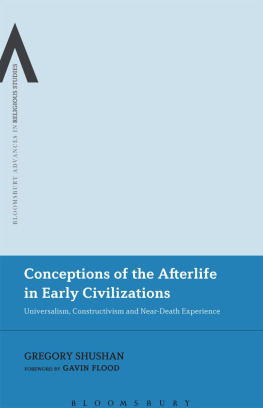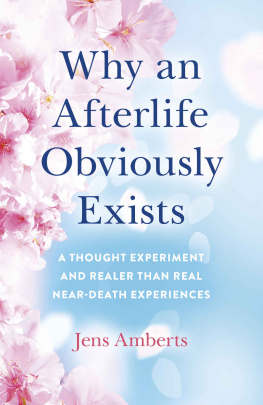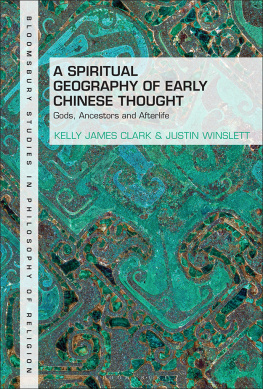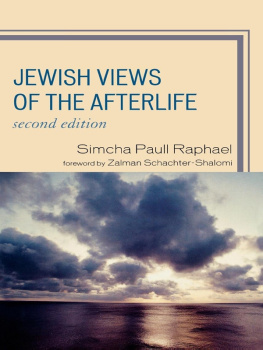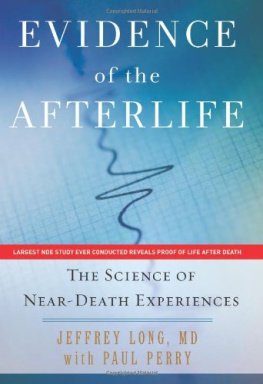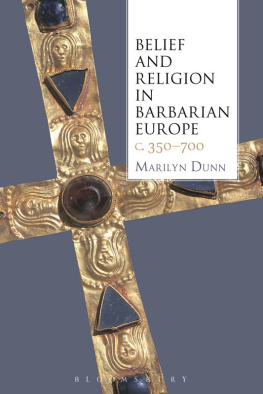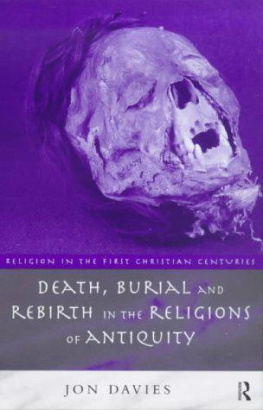Conceptions of the Afterlife in Early Civilizations
Bloomsbury Advances in Religious Studies
Series Editors: James Cox, Peggy Morgan
The Appropriation of Native American Spirituality, Suzanne Owen
Contemporary Western Ethnography and the Definition of Religion, M. D. Stringer
A New Paradigm of Spirituality and Religion, MaryCatherine Burgess
Religion and the Discourse on Modernity, Paul Franois-Tremlett
Theology and Religious Studies in Higher Education, D. L. Bird and Simon G. Smith
Conceptions of the Afterlife in Early Civilizations
Universalism, Constructivism, and Near-Death Experience
Gregory Shushan

Dedicated to my mother, for a sense of wonder, curiosity, and lifelong intellectual and creative inspiration beyond words; and to my father, to whom all the mysteries herein have been revealed, for the balancing counterweight of pragmatism and scepticism, and for planting the seeds of confidence and aspiration.
Contents
Foreword
The concern about death and whether there is conscious survival after death has been a central preoccupation of human beings since we first became self- conscious. Different conceptions of an afterlife developed in different civilizations, often linked to ideas about some kind of moral judgement. In this engaging and wide ranging book Gregory Shushan takes us on a fascinating journey through ancient ideas about the afterlife in Egypt, Mesopotamia, Vedic India, Mesoamerica, and pre-Buddhist China. But this is not simply a historical mapping of these early concepts, the author brings them to life and makes them relevant to contemporary concerns about what has become known as near-death-experiences. Part of the argument is that in these experiences people report a range of phenomena that have correlates in different cultures and different histories. Treading carefully through the difficulties of comparative religion, whether it is possible or desirable to offer comparisons, the author carefully examines the evidence from the past, offering a phenomenological account from different texts and different voices. From the phenomenological description we see that several themes emerge or more specifically the same set of thematic elements occurs, namely the idea of an afterlife journey, out of the body experiences, journeys to other non-physical worlds, encounters with deceased relatives, visions of a divine presence, and an experience of judgement about ones earthly life.
In presenting a study such as this, the author is not only giving an account of ancient civilizations but is also performing a comparative religion that takes seriously the challenges of the last thirty years. This is very good cross cross-cultural scholarship that points to the legitimacy of comparative study and the possibilities of comparative study in the future. The book critically engages with postmodernism and presents an argument that comparison is indeed essential to understanding human beings and their worlds. This is a bold and engaging book. The author does not shy away from difficult issues and lays down a challenge to postmodern relativism and the idea that all human experience is a cultural or social construct. There are, the author argues, human experiences especially the experience of death that cut across cultures and religions and that we all share. But these experiences are not simple or unaffected by culture; they are inevitably influenced by the languages we use, our societies, and the world-views we are born into. Reading this book one is left with a sense of the wide range of cultures that the human experiment has produced along with our perennial concern with the question of death and the possibilities of immortality and continuity.
Gavin Flood
June 2008
Acknowledgements
I am extremely thankful to the variety of specialists in various fields who generously gave their time to providing comments and criticisms which have informed and supplemented this research (though, of course, any errors made and any advice I failed to heed are my sole responsibility).
I would first like to thank Professor Paul Badham, whose knowledge of the issues and support of my approach were vital to the project; and Professor John Tait, whose perspectives and encouragement were important factors in its development. Invaluable assessments by Professor Gavin Flood and Dr Wendy Dossett of a longer version of the work were instrumental in it reaching its final form.
I would also like to express my deepest gratitude to those who helped with particular chapters: for Egypt, Dr Stephen Quirke, who gave a particularly thorough reading with detailed comments and insightful observations; for Mesopotamia, Dr Stephanie Dalley, whose helpful and encouraging comments led to some significant improvements; and Dr Martin OKane whose support extended to also giving a critical reading of my methodology; for India, Dr Maya Warrier, who made perceptive comments, raised pertinent questions, and pointed out an important additional text; and Professor Stephanie Jamison, whose thought-provoking criticism of my approach alerted me to the need for some re-organization and clarifications; for China, Professor Xinzhong Yao, whose expertise was essential in steering me through much difficult terrain; and Prof. Emeritus Jordan Paper, who also corresponded with me in some depth on cross-cultural comparison and mystical experience; for Mesoamerica, Professor J. G. Brotherston, whose useful comments helped with some key observations and clarifications; Dr Penny Dransart, who enthusiastically shared her wide-ranging knowledge of the civilizations and their religions; Professor Karl Taube, who made some keen observations and provided me with copies of his articles relevant to the subject; and Dr Elisabeth Graham, who engaged in a lively e-mail exchange regarding methodology, terminology, and diffusion, as well as Mesoamerica. Professor Mu-chou Poo made some insightful comments on comparative methodology which helped lead to a more focused work; and encouraging discussions with Dr Ruth Whitehouse helped me to refine my topic at its earliest stage. Also helpful were discussions with Dr Mark Fox on early and non-Western near-death experiences, Dr Penny Sartori regarding her clinical research into NDEs, Jennifer Smith on the Vedic afterlife, Professor Daniel Foxvog and Peter Westh on the Sumerian afterlife (via ANE-2 discussion list), and Ccilia Robache on universals, mourning, and various other matters.
Finally, the research would not have been undertaken without the support of the Arts and Humanities Research Council. Thanks also to the Centro Incontri Umani, Ascona, Switzerland, for a summer Research Fellowship which enabled me to prepare the manuscript for publication.
Abbreviations of Primary Sources
Note: Renderings of proper nouns have been standardized throughout to the most recent translations or transliterations (e.g. Zhuangzi is used instead of Chuang Tzu, regardless of translators rendering). Transliterations have been spelled phonetically, and diacritical marks omitted.
1. Old and Middle Kingdom Egypt |
CT | Coffin Texts (Faulkner 1973, 1977, 1978) |
Pyr. | Pyramid Texts (Allen 2005) |
2. Mesopotamia to the End of the Old Babylonian Period |
BEU | Bilgames, Enkidu and the Underworld (George 2003b) |
Next page
